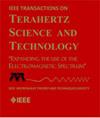太赫兹波段从牛眼孔径到平面硅波导的相位可控欺骗性表面等离子体耦合
IF 3.9
2区 工程技术
Q2 ENGINEERING, ELECTRICAL & ELECTRONIC
IEEE Transactions on Terahertz Science and Technology
Pub Date : 2024-04-22
DOI:10.1109/TTHZ.2024.3392157
引用次数: 0
摘要
我们展示了在自由空间传播的太赫兹波通过带有亚波长孔径的牛眼结构进入平面硅波导的欺骗性表面等离子体耦合。由衬底背面牛眼结构诱导的欺骗性表面等离子体极化子通过孔径传播到正面,并耦合到波导中。电磁场模拟显示,传播到正面的欺骗性表面等离子体极化子沿入射极化方向具有指向性,而且相位可以通过在开孔旁边放置一个 Y 形分支硅波导来控制。通过将带有牛眼孔径的镀铜基板与硅微加工制造的波导粘合在一起,制造出了一个原型装置。将来自后向太赫兹波参量振荡器的 0.42-0.49 太赫兹单色波注入牛眼结构,并测量波导末端的发射波强度。使用直波导时,根据入射偏振方向的强度变化,可以确认波导的定向耦合。此外,Y 形分支波导两端的相位差也通过强度变化得到了证实,根据极化方向的不同,Y 形分支波导两端显示出建设性或破坏性干涉。这些结果表明,可以通过欺骗性表面等离子体耦合控制相位,将入射波耦合到垂直于它的平面波导中,这表明它适用于太赫兹波段的新实验和实用系统,例如超越 5G/6G 的通信。本文章由计算机程序翻译,如有差异,请以英文原文为准。
Phase-Controllable Spoof Surface Plasmon Coupling From Bull's Eye Aperture to Planar Silicon Waveguide in the Terahertz Band
We demonstrate spoof surface plasmon coupling of a terahertz wave propagating in free space into a planar silicon waveguide through a bull's eye structure with a subwavelength aperture. Spoof surface plasmon polaritons induced by the bull's eye structure on the backside of the substrate propagate to the frontside through the aperture and couple into the waveguide. Electromagnetic field simulations revealed that the spoof surface plasmon polaritons propagating to the frontside show directivity along the incident polarization direction, and that the phase can be controlled by placing a
Y
-branched silicon waveguide beside the aperture. A prototype device was fabricated by bonding a copper-plated substrate with a bull's eye aperture and a waveguide fabricated by silicon micromachining. A monochromatic wave of 0.42–0.49 THz from a backward terahertz-wave parametric oscillator was injected into the bull's eye structure, and the intensity of the emitted wave from the end of the waveguide was measured. Directional coupling into the waveguide was confirmed from the intensity change depending on the incident polarization direction when using a straight waveguide. In addition, the phase difference between the two ends of the
Y
-branched waveguide was confirmed by the intensity change showing constructive or destructive interference depending on the polarization direction. These results indicate that it is possible to couple an incident wave into a planar waveguide perpendicular to it by controlling the phase via spoof surface plasmon coupling, suggesting its applicability to new experimental and practical systems in the terahertz band, such as beyond 5G/6G communications.
求助全文
通过发布文献求助,成功后即可免费获取论文全文。
去求助
来源期刊

IEEE Transactions on Terahertz Science and Technology
ENGINEERING, ELECTRICAL & ELECTRONIC-OPTICS
CiteScore
7.10
自引率
9.40%
发文量
102
期刊介绍:
IEEE Transactions on Terahertz Science and Technology focuses on original research on Terahertz theory, techniques, and applications as they relate to components, devices, circuits, and systems involving the generation, transmission, and detection of Terahertz waves.
 求助内容:
求助内容: 应助结果提醒方式:
应助结果提醒方式:


